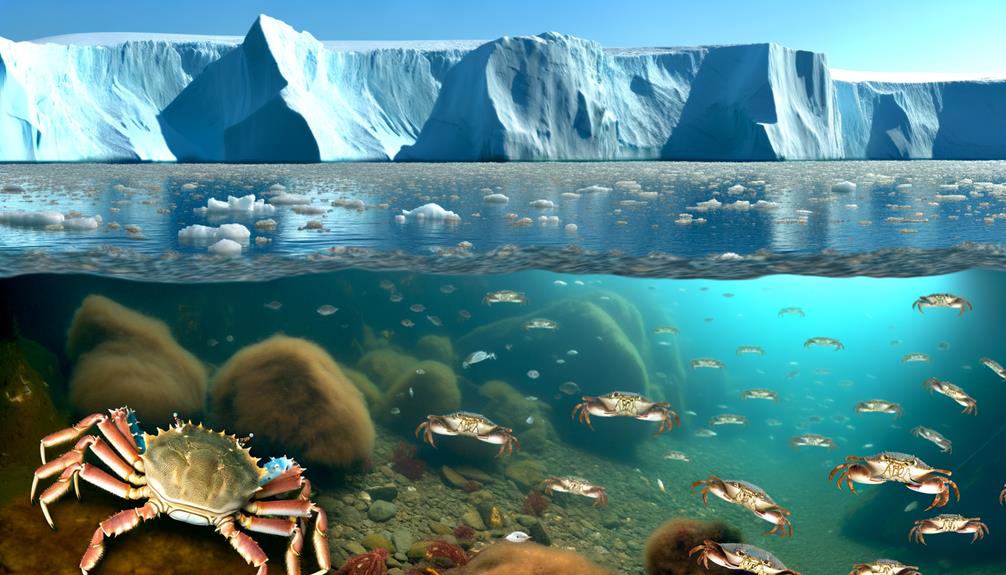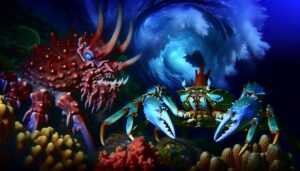Top 3 Benefits of All Living Things Hermit Crab Food
When comparing Alaskan King Crab to Snow Crab, you'll notice key differences. King Crabs, inhabiting deeper Bering Sea waters, can weigh up to 10 kg with a 1.8-meter leg span.
Snow Crabs live in the North Atlantic and North Pacific, usually weighing between 0.5-1.4 kg, with a 0.6-meter leg span. Their exoskeletons differ significantly; King Crabs have spiky, robust shells while Snow Crabs have smoother, lighter ones.
This impacts their defense mechanisms and ecological adaptability. King Crabs offer a rich, sweet flavor and dense meat, while Snow Crabs deliver a delicate, briny taste with flaky texture.
Explore more fascinating contrasts.

Key Takeaways
- Alaskan King Crabs are larger, weighing up to 10 kg, while Snow Crabs typically weigh between 0.5 to 1.4 kg.
- King Crabs have a richer, sweeter flavor and firmer meat compared to the delicate, briny taste and flaky texture of Snow Crabs.
- King Crabs inhabit the Bering Sea at deeper depths (90-300 meters), whereas Snow Crabs are found in the North Atlantic and North Pacific Oceans (70-200 meters).
- Sustainable fishing for both species involves pot traps with tightly controlled quotas to minimize environmental impact and bycatch.
- Nutritionally, both provide high protein and essential vitamins, but Snow Crab is leaner with fewer calories, while King Crab has higher zinc content.
Habitat and Distribution

Alaskan King Crabs primarily inhabit the cold, deep waters of the Bering Sea. You'll find them at depths ranging from 90 to 300 meters. Their preference for colder, deeper waters means they're adapted to a unique ecological niche.
Snow Crabs, on the other hand, are more commonly found in the North Atlantic and North Pacific Oceans. They thrive in shallower waters, typically between 70 and 200 meters deep. Snow Crabs often inhabit areas with sandy or muddy substrates.
The geographical distribution and depth preferences of these species are influenced by various factors such as water temperature, salinity, and available food sources. Understanding these habitat distinctions enables you to appreciate the ecological adaptations that contribute to their survival and proliferation in distinct marine environments.
Size and Weight
When comparing the size and weight of these two species, you'll find that King Crabs far outsize Snow Crabs, with some individuals weighing up to 10 kilograms and measuring up to 1.8 meters across their leg span.
In contrast, Snow Crabs typically weigh between 0.5 to 1.4 kilograms and have a leg span reaching up to 0.6 meters. This significant disparity in size can be attributed to their respective growth rates and environmental adaptations.
King Crabs' larger size provides them with a competitive advantage in predatory behavior and territory dominance. On the other hand, the smaller Snow Crabs are more agile, enabling them to exploit different ecological niches.
Such size variation directly influences their ecological roles and fishing regulations.
Shell and Appearance

How do the distinctive shell structures and appearances of King Crabs and Snow Crabs affect their adaptability and survival in their respective environments?
King Crabs possess robust, spiky exoskeletons that provide excellent defense against predators and harsh conditions in the deep, cold waters of the Bering Sea. Their red-brown hue offers camouflage amidst the rocky seabed.
Conversely, Snow Crabs feature a smoother, lighter shell, optimizing their mobility on the sandy, shallow ocean floor. Their lighter coloration blends seamlessly with the snowy ice habitats they frequent.
These morphological adaptations enhance their survival rates by reducing predation risks and improving environmental integration. You'll find that understanding these anatomical differences reveals how each species thrives within its specific ecological niche.
Taste and Texture
Examining their taste and texture, King Crabs deliver a rich, sweet flavor with firm, succulent meat, while Snow Crabs offer a more delicate, slightly brinier taste combined with a tender, flaky consistency. Data indicates that King Crabs' meat density is higher, providing a robust bite that complements various culinary applications.
Analytical assessments reveal that Snow Crabs, on the other hand, exhibit lower muscle fiber density, resulting in their characteristic flakiness.
When evaluating taste profiles, King Crabs' glycine content contributes significantly to their inherent sweetness. Contrarily, Snow Crabs contain higher amounts of amino acids like taurine, which enhance their subtle briny notes.
Understanding these differences allows you to make informed choices based on your preferred flavor and textural experience.
Nutritional Value

Both Alaskan King Crab and Snow Crab offer a wealth of nutritional benefits, each species boasting significant levels of protein, essential vitamins, and minerals.
Alaskan King Crab contains approximately 19 grams of protein per 100 grams, providing a robust source of amino acids essential for muscle repair. Snow Crab, slightly lower, offers around 18 grams of protein per 100 grams.
Both crabs are rich in vitamin B12, enhancing neurological function, and selenium, an antioxidant aiding in DNA synthesis. Additionally, they provide omega-3 fatty acids, beneficial for cardiovascular health.
While Snow Crab contains fewer calories, making it a leaner option, Alaskan King Crab's higher zinc content supports immune function. Both species are low in saturated fat, promoting overall heart health.
Fishing and Sustainability
When comparing Alaskan king crab and snow crab, you should consider the distinct fishing methods used and their respective environmental impacts.
Alaskan king crab fishing often employs pot traps, resulting in lower bycatch rates compared to the trawling techniques frequently used for snow crab.
Data indicates that these differences notably affect marine ecosystems, informing sustainability assessments.
Fishing Methods Comparison
Sustainable fishing practices for Alaskan king crab and snow crab hinge on effective quota systems and rigorous monitoring to prevent overharvesting. You'll find that king crab fisheries employ pot traps, which are designed to minimize bycatch, enhancing sustainability. These traps are set on the ocean floor and retrieved after a set period, ensuring only legal-sized crabs are harvested.
In contrast, snow crab fishing also utilizes pot traps but operates in different depths and conditions. Quotas are tightly controlled based on stock assessments, ensuring population stability. Using data-driven methods such as satellite tracking and onboard observers, fishing fleets maintain compliance with regulations.
Environmental Impact Analysis
Analyzing the environmental impact of Alaskan king crab and snow crab fisheries reveals critical data on ecosystem health and resource management.
You'll find that Alaskan king crab fishing usually involves pot traps, which minimize bycatch and habitat destruction. Conversely, snow crab fisheries often employ similar methods but require more frequent trips due to differing population densities.
Scientific studies indicate that Alaskan king crab populations are more susceptible to overfishing, leading to stricter regulations. Sustainability efforts for both species emphasize quota systems and seasonal restrictions, ensuring long-term viability.
Conclusion
In comparing Alaskan king crab and snow crab, it's clear each has unique attributes. Alaskan king crabs are larger, with thicker shells and a richer taste, while snow crabs are more accessible and sustainable.
Nutritionally, both offer valuable proteins and minerals. So, which should you choose? It depends on your priorities: size and flavor or sustainability and availability.
By understanding these differences, you can make an informed decision that suits your culinary and environmental preferences.






